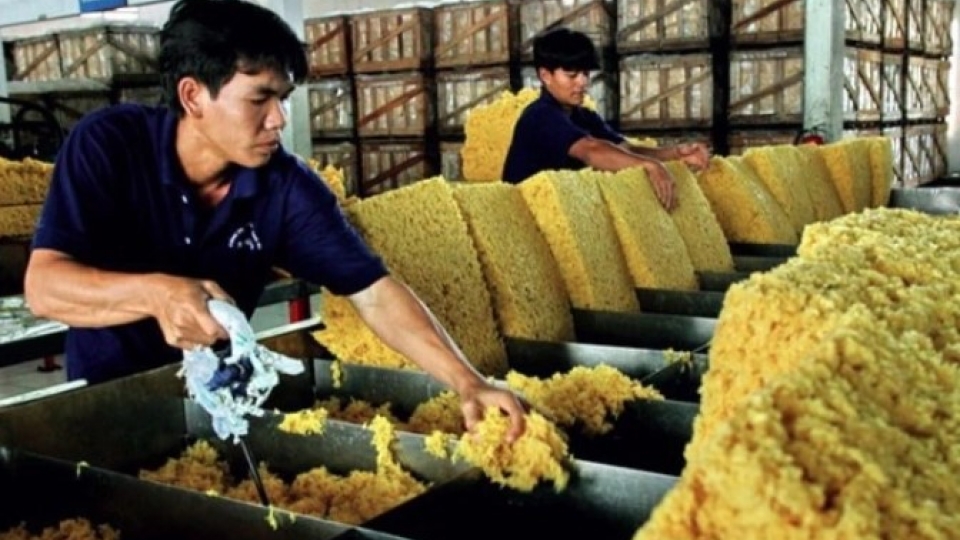Policy push needed as Vietnam moves to grow EU rubber exports
VOV.VN - Stricter traceability and sustainability rules are creating new hurdles for Vietnam’s rubber exports to the EU, highlighting the need for stronger policy support.

EU accounts for 7.4% of Vietnam’s total rubber export value
According to Vietnam Customs, rubber exports reached 550,140 tonnes worth US$1.04 billion in the first five months of 2025. This marks a 4.1% drop in volume but a 21.7% increase in value year-on-year. The average export price rose 26.9% to US$1,905 per tonne, showing a global rebound that helped boost earnings.
The Vietnam Rubber Association (VRA) notes that the sector plays a vital role in agricultural exports. Annual revenue from natural rubber and rubber products remains steady at around US$7-8 billion. The EU continues to serve as a strategic market, accounting for about 7.4% of total export value for these two categories. Of this, 95% comes from high-value-added rubber products.
Natural rubber shipments to the EU remain modest, representing just 3–4% of Vietnam’s total natural rubber exports. However, exports to the potential market rose in 2024 even as overall shipments to other markets declined. This signals a shift in market orientation as the nation adapts to the EU Deforestation Regulation (EUDR). It also affirms the EU’s growing importance in Vietnam’s sustainable export value chain.
The EU remains a priority market for Vietnam’s rubber products, with annual exports reaching US$450–470 million, or around 9–10% of total sector revenue. Main exports include tires, medical gloves, and technical rubber parts. Among these, tires bring in over 70% of the value.
Policy support urgently needed
The EUDR, adopted in 2023 and set to take effect in early 2026, will require seven commodity groups, including rubber to comply with all production and export regulations in their country of origin. Producers must also demonstrate that their operations do not contribute to deforestation.
Vietnam’s rubber supply chain is highly fragmented. Around 63% of raw materials come from household farmers, while 37% is sourced from large-scale plantations. This does not include imports, which are roughly equal in volume to domestic supply. Ensuring EUDR compliance requires early-stage coordination, especially where smallholders and local traders are responsible for supplying key traceability information and verifying the legality of raw materials.
However, the capacity to comply with EUDR varies across businesses. Foreign-invested and state-owned enterprises generally enjoy stronger traceability due to simpler supply chains and better resources. In contrast, private companies face greater challenges, as they rely heavily on raw materials from scattered smallholdings and often lack the funds to invest in traceability systems.
At the upstream level, smallholders remain the primary suppliers of raw materials but are the least prepared for EUDR compliance. Their operations are largely informal and shaped by habit. Many still lack access to information on legal and sustainability requirements, making traceability almost unfeasible under current conditions.
According to To Xuan Phuc, a policy analyst at Forest Trends, most current supply chains in Vietnam’s rubber industry fall short of EUDR requirements. Major barriers include the absence of digital plantation maps, missing land tenure documentation, informal transactions between farmers and traders, and limited technological capacity.
He also adds that international markets are moving firmly toward mandatory traceability standards. The shift is not limited to the EU. Vietnam’s rubber industry must recognize this trend and take action to restructure its supply chains. This includes both regulatory reforms and operational changes by producers and exporters. A successful transition will require broad-based effort from government agencies, industry associations, businesses, and smallholders alike.
To sustain and expand market share in the EU, Phuc calls for targeted technical and financial assistance, especially for private firms, traders, and smallholders. He also urges the development of a shared national traceability platform, stronger public–private partnerships, and deeper engagement with key markets like China, the US, and the EU. These steps will not only support EUDR compliance but also enhance Vietnam’s competitiveness in global trade.
Additionally, compliance strategies should be tailored to different types of enterprises. Short, medium, and long term policies should be rolled out in phases to match the realities of current business operations and optimize available resources.
Finally, Vietnam should step up regional cooperation among rubber-producing countries to jointly advocate for a transitional mechanism with the EU. A grace period of 2–3 years could help take into account Southeast Asia’s specific conditions and give exporters time to adapt without losing market access. Clarifying EU expectations and the implementation roadmap will be key to maintaining sector stability during the transition.



